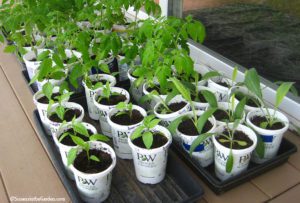April 2 Column: Protecting Seedlings from the Weather

Does the photo to the left look like your place these days? Have you got plants stashed all over the place, waiting for the weather to warm up? This week’s column is about protecting seedlings from the weather, which is very important.
I mean, you just went to all of the trouble to raise them, right? Well, before you move them to their permanent home in the garden, stop! You’ll want to go through a couple of simple steps to ensure they’re ready.
Here is a link to my column in today’s edition of The Spokesman-Review: Protecting plants from the weather. Or you can read my column below (don’t miss this week’s video underneath it!).
Column:
by Susan Mulvihill
It’s too early to transplant our seedlings out in the garden. But a few mild days can make any gardener want to jump the gun. Unfortunately, this can lead to disastrous results in this region.
In the Inland Northwest, we typically have frosts until the middle of May. Savvy gardeners always keep an eye on the weather forecasts to be safe. They know protecting seedlings is very important.
It will soon be time to plant our cool-season crops in the vegetable garden. They include beets, carrots, kale, leeks, lettuce, parsnips, onions, peas, spinach and Swiss chard. These crops are planted in early spring, once the soil is dry enough to work with. I hope to plant most of mine in about two weeks.
What about warm-season crops? (i.e., cucumbers, eggplants, melons, peppers, pumpkins, squash and tomatoes) They should be planted after all danger of frost has passed.
Two methods of protecting seedlings
If you have started any cool- or warm-season crops indoors, there is an important step you need. That way, they will be ready for their new life in the garden when the time comes. The step is called acclimating them to sunlight and outside temperatures.
Just like we humans, young plants will get sunburned. That’s what happens if they go from spending their days indoors to being out in direct sunlight full-time. Have you ever done this to seedlings? (don’t worry, you can admit it because I’ve done it, too) You’ve seen how their leaves turn a sickly white color. That’s because they’re not used to the full intensity of the sun. Of course, we humans do the opposite, by turning a bright shade of red.
Hardening-off seedlings
A little advance planning is in order. A week to 10 days before you plan to transplant your seedlings, start moving them outside. I recommend a sheltered area such as a deck. Don’t put them in full sun or in a windy area. The first day, they only get to be outside for an hour and then moved back indoors. The next day, it’s for two hours, and so on. By the time you’re ready to plant them, they’ll be ready for the real world, too.
Use floating row cover
Now, call me over-protective, but there’s another step I go through. I want to keep my plant babies safe from surprise frosts. This primarily applies to warm-season crops. But it also applies to my pea seedlings since an unexpected frost can really set them back. I cover the plants for the first two weeks of their outdoor lives.
There is a fabric-like product called floating row cover that is very helpful for this. You can purchase it at large garden centers or online. Row cover is a lightweight bonded fabric that looks like the interfacing used in garments.
It lets air, light and moisture through, but also gives a few degrees of frost protection. That makes it useful both early and late in the growing season. I have hoops over my raised beds, which are made from flexible black sprinkler pipe. The hoops support the row cover. The ends are held down with bricks so the wind won’t blow it off the beds.
Try keeping floating row cover on your warm-season crops for a couple of weeks. You’ll be amazed at how well the plants grow thanks to this protected start. Just remember to remove it before the plants start blooming so the bees can work their pollination magic.
Learn more about protecting your plants from the weather in my video below.
This week’s video:
In the video, I elaborate on these important tips and show you materials you can use to protect your plant babies. Have a look:

